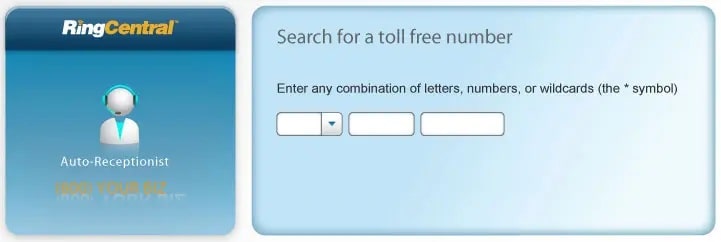Your business is operating in a highly competitive world, and no doubt you’re constantly dreaming up ways to outshine your rivals. But your strategies don’t have to be complex—one of the simplest business ideas is to get yourself a free telephone number.
Everybody loves to feel they’ve made a saving, so an 800 number makes a valuable marketing tool to encourage both new and existing customers to get in touch. Here, we’ll show you how free numbers work, how to get one, and how providers like RingCentral can help you optimize the service.

What is an 800 phone number?
An 800 number is one of several toll-free phone numbers available in the USA. It’s definitely the most recognizable one, and therefore the most popular choice for businesses.
A toll-free number means that your customers won’t be charged for making the call. Toll-free calls are routed to a local number. And the owner of the number pays the cost of the call.
To distinguish them from ordinary landline numbers, toll-free numbers all have a unique three-digit prefix. As well as 800, the numbers 888, 877, 866, 855, 844, and 833 are used. No matter which one your company chooses, callers can dial these numbers for free.
Back in the day, toll-free numbers were only employed by large businesses—but now they’re much more affordable and are used by organizations and individuals across the country.
It’s also possible to buy a toll-free vanity number that spells out a memorable word or business name alongside the digits, such as the well-known 1-800 FLOWERS.
How did 800 numbers start?
800 numbers were first introduced in 1967 by AT&T, who wanted to cut down on labor-intensive collect calls requiring a live operator. The service was initially adopted by hotels and car rental companies that received reservations from across the country.
Eventually, more businesses took up the idea, which developed into the concept of the call center. But the toll-free service wasn’t particularly cheap, and switching carriers was also costly as firms had to begin using new toll-free numbers.
In 1993, an FTC ruling on ‘portable’ numbers meant that customers could pick a new carrier and bring their 800 numbers with them. Small businesses could now get in on the act, and prices were driven down due to competition between carriers.
Initially, all toll-free phone numbers used the 800 prefix. But since then, extra toll-free prefixes have had to be created to meet demand. The latest extension, 844, was released in 2017 and offers scope for vanity numbers with words up to seven characters.
All toll-free numbers are housed in a national registry. This toll-free directory is kept by a company called Somos, Inc., which permits companies known as RespOrgs (Responsible Organizations), such as RingCentral, to assign toll-free numbers on a first-come-first-served basis.

Benefits of a toll-free number
Whether you choose an 800 number or another toll-free prefix, there are many reasons why free calling should be a crucial part of your business strategy. The advantages of toll-free numbers include the chance to:
- Incentivize customers
- Look professional
- Cover more ground
- Streamline your advertising
- Boost your bottom line
We know that it’s way cheaper to make phone calls than it used to be, thanks to free minutes and generally lower charges. Customers may not be so worried about cost, but it’s still a nice feeling to get something for free.
They’re also more inclined to give you a call on a toll-free number, which offers your team an opportunity to deliver five-star service. And if someone calls you with a complaint, they’ll undoubtedly feel less annoyed if they don’t have to pay for it!
Despite the rise in digital channels, many people still prefer to call a business phone number and speak to a human agent. Making this option free will help you build positive relationships with a broader range of customers.
Toll-free numbers also help your business appear more professional and established because people still associate them with successful companies. As they’re not restricted to a specific geographic location, you can cover more markets—and customers across the world can use the same number to reach you.
Using one toll-free number to cover multiple branches of your business makes it easier for people to remember, and you can simplify your marketing. Choosing a memorable vanity 800 number incorporating your name or slogan will boost your brand recognition and improve ad response rates.
Most toll-free number service providers allow call forwarding to your existing phone numbers and cell phones, so customers can reach you wherever you are. You can also call or text from the 800 number and set rules for inbound calls based on variables like business hours.
Home-based business owners can keep work and personal life separate with a dedicated toll-free business line. And sole traders or those without physical premises can handle all business calls from their cell phones.
Employing a business VoIP service provider like RingCentral, will also allow you to make cheaper calls. You don’t need any special hardware or extra phone lines, as you can use a computer or mobile device to receive calls. VoIP phone systems also provide you with advanced features like call blocking, call routing, and an auto attendant.

Optimize your toll-free number
It’s essential to have your 800 number listed prominently on your website, so people can see easily that it’s a communication option. Let’s say a prospective customer encounters an issue at checkout—it would be fastest to speak to a human, but it’s likely they won’t want to spend extra money doing so.
Make sure you answer all incoming calls quickly. The goodwill gained by not charging for the call will quickly evaporate if your customer is put on hold for ages!
You should also capture and analyze customer data with technology like call recording and speech analytics. This not only helps you improve customer service but also enables you to get back in touch for a future follow-up or upselling opportunity.
How do I get an 800 number?
As we mentioned, 800 is the most popular toll-free prefix, so they’re often in high demand and short supply. And if you’re after a vanity toll-free number, you might have to be more creative with the word you pick, as it’s likely that your preferred business name will already have been snapped up.
If you can’t get hold of a coveted 800 prefix, don’t worry. Internet-savvy customers often use search engines to look up toll-free numbers and research the company before calling. So those without an 800 number should place low-cost ads through Google Adwords—either displaying their own number in the ad or redirecting people to a website.
There are hundreds of business phone service providers offering toll-free, virtual, and vanity numbers. You could just run an online search and pick the first one you see. But before you make a choice, here are some things you should look for:
- Wide choice of numbers
- Ease of adding new numbers
- Flexibility to transfer existing numbers
- Affordable and transparent pricing
- Reliability and security
- Integrations with phone systems
Almost all virtual phone service providers can assign you a toll-free number. But remember that not all of them offer call management tools and integrations to help you make the most of it. Reputable providers like RingCentral build all the required features into a complete virtual phone system.

Which is the best service provider?
1. The type of VoIP provider
There are three main categories of VoIP providers to suit different business needs.
- Call recording
- Voicemail transcription
- Call analytics
- Send and receive text messages
- Receive faxes
The intuitive dashboard is easily manageable from your browser, desktop apps, or mobile apps for iOS or Android.
RingCentral’s VoIP phone system is the most productive and the cheapest way to handle business communications, as advanced telephony services are combined with other digital channels and tools for management and collaboration. You’ll get cheaper calls across the board, and it also allows number-sharing across multiple devices and apps.
In short, buying 800 and other toll-free numbers from RingCentral gives you access not only to the benefits of toll-free services but also maximum efficiency, reliability and security. It’s an excellent way to ensure happy customers and increase your profit margin.
